1. The Old Hungarian script
1. Prior to the adoption of the Roman alphabet in the early XIth century, Hungarians used a set of sound-signs of Phoenician origin for writing. The historical term for this old system of writing is Rovás, meaning 'incised, engraved' or 'carved' script, the name describing the technique of writing. Foreign language scientists called it "linear" or "geometric shaped" script, thereby alluding to the form of writing.
On this subject, there is an abundant literature beginning with the very precious Latin language work of J. Telegdi from 1598 (reproduced in P 115 p. 91 and f.). More recently, two eminent comprehensive works were written, one by Gyula Sebestyén (P 115 and P 116), and the other by Dezső Csallány (P 035). Thanks to these and to similar other publications, we have a perfectly clear idea how this system worked: we know which were the sound-signs, the rules of writing and the writing material as well. In addition, some forty extant original inscriptions allow us to see the system in operation. The incised or linear script was, in all probability, invented in the ancient Orient, although the specific area remains unknown. It is, however, clear that the earliest form of this writing was simplified by Phoenician scribes who then spread it all over the Mediterranean from the XIth century B.C. onward. It is also known that a similar type of writing existed in the Indus valley already in the second millenium B.C. In subsequent times, this was also simplified and spread to Lower and Upper Asia, mainly amongst Turkish peoples. Finally, following the opinion of Sir Flinders, then Petrie, several scientists maintained that the earliest incised signs were used at Abydos, in the Upper Nile valley for the purpose of pot-marking, in Neolithic times around 3200 B.C. Thus, a higher chronology seems to be preferable for this invention, the more the ancient Hungarian word for scribe is Tudo, which is the same in ancient Egyptian (Tutu and Thot), in Sumerian (Tudu) and also in Finnish (Tataa).
After Hungary's conversion to Christianism, the carved script, like everything associated with paganism, became a liability. Therefore, its use was banned by King St. Stephen (1000-1038) who also ordered the destruction of all the existing records written with the "diabolical letters." With the passing of time, the existence of the Old Magyar writing was almost totally forgotten. Its last vestiges were swept away with the appearance of modern writing material and the invention of printing.
What we know about the sound-signs of the Hungarian carved script, may be summed up in the following. First., that in the XIIIth century, under the impact of the Roman alphabet, the list of the Hungarian sound-signs was gradually enlarged, to become a regular alphabet, i.e. having a special sign for each sound. But up to that period, and earlier in history, this writing used a considerably smaller number of graphic signs. The paucity of the signs required is explained by the fact that in this writing there is no difference between short and long vowels, consequently it needs only five signs to write them instead of fourteen. Furthermore, the scribes often used unvoiced consonants (T and P) to write their voiced counterparts (D and B), whereby new cuts could be made. The number of required writing symbols were even further reduced by eliminating the vowel signs. This was possible by the particular character of Hungarian, wherein vowels have no grammatical role, the root remaining always unchanged. The "vowel dropping" or "vowel jumping" as this practice was called, was further justified by invoking the phonetical particularity that every consonant already includes a vowel sound with which it is uttered. Thus, adding a special sign for this vowel, would be superfluous. At this stage, the names Barabas and Aladar could have been written as B-R-B-S and L-D-R respectively and the reader had to supply the necessary vowels in speech. With the almost total elimination of vowels, the consonants have taken over the leading role in the writing. Therefore, the carved script was also called a "consonantal script."
According to the principal rule of writing, all words were to be written phonetically, as they were uttered, irrespective of etymology, exactly as in present-day shorthand. A second rule required that the words of a given message be written immediately one after another, without separating them by a white space or in any other way. Thirdly, the direction of writing depended largely on the nature of the writing material. In the earliest times, and as long as the writing was done with a knife on small sticks or wooden tablets, the direction was usually from right to left. In more recent times, when paper, ink and pen came into use, the natural direction of writing with the right hand went from left to right, starting at the upper left end of the paper.
Writing by incision on wood, stone slabs or metal plates was a time-consuming operation, especially when the place of the individual signs had first to be marked out for some valid reason, such as symmetry or exiguity of space. Thus, the need for accelerating the writing appeared very soon. The easiest way to do this consisted of creating abbreviations for the most frequently used words, such as God and Sun. But the most effective method consisted of combining two or more signs into a single figure, saving strokes here and there. Such graphic contraction or "ligatures" most frequently resulted in the case of N and T, S and T, A and R, K and R, etc. (see the sign-lists, Fig. 14). The frequent use of combined signs was a special feature of the Hungarian incised writing at its zenith. The principal rules of the carved script must always be kept in mind, not only when we are deciphering inscriptions in Hungary, but in examining Ancient Near-Eastern inscriptions as well, the principles of old writings having been the same everywhere and in all systems. The Old Hungarian writing was often called a "Scythian script", "Hunnic way of writing" or "Siculi alphabet". These three denominations are as many indications warning us that several socio-cultural groups (Scythians, Huns, Siculs) were using the Magyar writing system in the Danube basin prior to the advent of the Arpad Hungarians in 895 A.D. In other words, they must all have been interrelated Hungarian type of nations.


Fig. 14. The O.H. alphabet
A similar conclusion results from the fact that the knife, which was the principal writing instrument all over South-Western Asia, was known everywhere by the Hungarian word Kés (pron. Kash). For example, the deadly knife every Scythian kept in his boot-leg, was A Cina Kesh. This word Kés is mentioned several times by Ptolemy in his Geography when describing the Oxus region. Knife, even in the ancient Egyptian language was Kesh. These data will help researchers figure out the vast area where the Hungarian version of the carved script was in use.
2. Let's now consider three specimens of the Old Hungarian script. The first one (Fig. 15) was found on the old wall of the Presbyterian church of Dálnok in the Háromszék county during repairs. It uses frequent ligatures and reads from left to right. We transliterate it thus: eSZ.T aR-éG.I Fa(l)-R-A. Ró-Ja Ó-Ko.Ri Ma-G.aR R.O-N-A-/K-aL/. With present Hungarian spelling: Ezt a régi falra rója ókori magyar rúnáikkal/. In English: 'This is being incised on the old wall /with/ archaic Magyar rune/s/.(20)
The second inscription shown (Fig. 16) was incised on the wall of the Ambassadors' Hostel in Constantinople (Turkey). It records, in three lines, the rough handling of the members of the embassy, sent to Sultan Selim I by King Ladislas of Hungary in 1515. The inscription was first deciphered by William Thomsen (Copenhagen), then completed by Gyula Sebestyén, and corrected by Dezső Csallány (P 035 p. 77). It reads from right to left, the first line (only reproduced here) saying: 'This was written in the year 1515 when King Ladislas' five envoys were kept there waiting.'
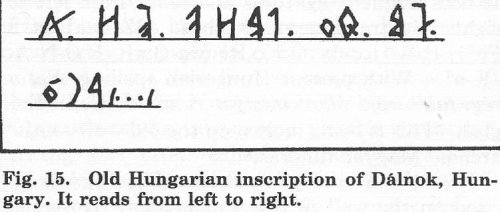
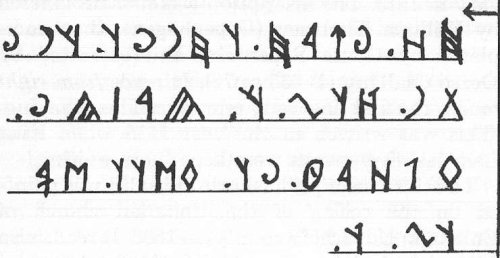
Fig. 16. Old Hungarian inscription of Constantinople, Turkey. It reads from right to left.
The third inscription shown (Fig. 17) was painted on the ceiling of the Unitarian church of Enlaka in Udvarhely county, in 1688. It reads also from right to left and proclaims the fundamental doctrine of the Unitarian confession, that God is only one person (contrary to the Catholic doctrine of Trinity). The same principle is repeated twice nearby in Latin thus: "Deus unicus" and "In honorem unius veri Dei". The message in Hungarian runs thus: Egy az Isten. Deut.VI. Georgyius Musnai deakon, 'God is (only) one. Deut. VI., George Musnai deacon.'
3. A pleasant feature of the Old Hungarian script was that its inscriptions were quite frequently accompanied by some pictorial drawing, as is the case in the Enlaki (Fig. 17) inscription. These pictures are not only added for the sake of illustration; they are fulfilling a more important role: they usually emphasize the main point of the message. As such, they constitute a special kind of writing with pictures. As was already illustrated when dealing with the Magyar and Kush symbols, this method of idea-communication was based upon the homophony existing between two different words, mostly between a noun and a verb, i.e. between a concrete and an abstract idea. Examples: Fog as a noun signifies 'Tooth' and as verb it means 'To grasp'; and Hal is 'Fish' as a noun and 'To die' when it is a verb. Now, to write the abstract idea 'To grasp' or 'To die', the scribe had to revert to the concrete object to write the pictorially inexplicable idea. In such cases, either the context or some additional sign warns the reader that the sound-signs signify something abstract. Given the very special character of the pictorial writing, if we can successfully decipher such writing in Hungarian, we thus have the decisive proof that the text is in Hungarian.
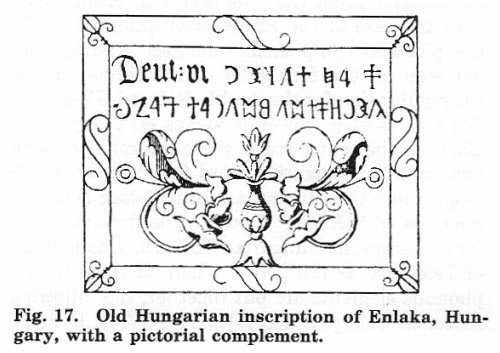
In the case of the Enlaki inscription (Fig. 17), the pictorial complement includes a paragraph-like sign on the four sides of the frame; this is the regular sign for the double-lettered GY-sound. With its built-in vowel, it means eGY, egy 'one'. Then, in the centre-stage, there is a milk-jar with flowers. The Hungarian word for milk-jar is Köcsög, whose Old Hungarian form Kétség is homo-phonous with Kétség 'Doubt'. The flowers in the jar are tulips, in Hungarian Tulipán, a homophon of Tele-van, 'Is full'. Now, when all these homophonous elements are put together, the following sentence emerges: EGY-KETSEG-TELE-VAN.
In present day Hungarian: Egy kétségtelen van, indicating once again the Unitarian dogma: 'One (divine person) doubtless exists.' Of course, for a reader not versed in Hungarian, it is not easy to follow the acrobatic stunts displayed by the scribes of pictorial messages.
In conclusion, we may say that the Hungarian carved script dates back considerably farther than was supposed until now and that its importance goes far beyond what was acknowledged by certain foreign authors. The Old Hungarian script is a strong link which binds the Hungarians to the Near-East where the first literate nations of the world had emerged. All that has a considerable bearing upon the historical role of the early Hungarians.
2. The Old Hungarian faith
1. It is a foregone scholarly conclusion that zealous Magyar kings of Christian Hungary put all their energy into eradicating the last roots of the old pagan creed from the Magyars' soul.(21) These kings, indeed, ordered the destruction of the heathen altars and temples, and severely punished the venerators of rivers, fountains, groves, trees and stars. The kings also persecuted the diehard servants of the ancient divinities, treated them as pariahs and committed them to the care of Saint Lazar. Whatever element of the old belief and custom escaped the purge was baptized and incorporated into the new religion, or relegated into the realm of folklore.(22)
It would be, nevertheless, a hasty conclusion to say that the Magyar kings totally succeeded in brainwashing all segments of the population. There remained, indeed, much evidence proving the survival of the old faith, not only in folklore and place-names, but even in the royal administration. Moreover, the elements constituting the old faith were to a great extent brought into the Christian religion, including the very name of the heathen god, so that Christianization cannot be interpreted as total break with the past. As a major proof of this, Arnold Ipolyi, author of a monumental "Hungarian mythology", was able to collect a more than ample documentation about the old faith as late as the second half of the XIXth century. Moreover, the work of Ipolyi has been completed since then, with plenty of new, detailed data. What the otherwise successful scientists were unable to prove, however, was the positive identification of the chief Magyar divinity: the Sungod. Therefore, they also failed to established the relationship of the Magyar faith to the great Oriental solar religion, especially with that of Egypt.
2. An Arab historian, Ibn Rusta, in reporting about Hungarians of the IXth century, observed that "they are worshippers of the Sun and the Moon." This summary statement emphasizes the root of the matter, which can be advantageously completed with Magyar sources. In a pagan Magyar hymn to the Sun, we read for example this: "Thou art the primeval Tree of Life... from which everything springs; by which the night of evil spirits is chased; to which everything in this world returns" (P 130 p. 7). The rising Sun was greeted by the farmers of the Csik county with their hats off, and with the following words: "Be welcome, oh Sun, thou bringest us daylight and giveth warmth to our soil. Be blessed, thou, who disperses the dark clouds, and ripens our ears. Be glorified thou, who waters our crops and adorns our fields with flowers" (P 125 p. 339 and f.; P 020). These quotations prove that their idea of God included the belief in a divine creation, and that God governs the created world. It is also clear that the Sungod was mostly venerated in his capacity as tutelary deity of the agricultural population. His most important task was to illuminate the Earth, which he did by means of a shining globe that travelled daily across the firmament from east to west.
God's principal residence was supposed to have been in Heaven, inside the fiery disk, called Nap 'Sun'. He also had dwellings on Earth, especially in stone idols, called Bálvány (< O.H.: Baluan = Bál-Hon), 'Idol', literally 'God's home', in Latin Simulacrum 'Hiding place'.(23) The numerous stone idols served as appropriate places for God to keep a close watch over the behaviour of his creatures. Other earthly houses reserved for God were the temples, built in a round shape and therefore called Rotundae in Latin. The inside diameter of such temples hardly measured over four to six meters and they were erected during the XI-XIIIth centuries; about a hundred of them have already been identified. In spite of the fact that they were erected in the Christian era, they could not have been intended for Christian rites, because all the believers could not attend the ceremonies in such a small space. Several place-names refer to the former existence of Rotundae, being compounded with the word Kerek 'Round', such as Kerek-Egyház a, 'Sacred House of the Round Shaped God'; Kerekes-Kápolna 'Circular Chapel.' Many other villages in Hungary are called Eger-szeg (Ég-Ur-Széke) 'Throne of the Heavenly Lord', suggesting that in such places too, regular divine services used to be held. Still other places were reserved for religious feasts. These were often hilltops, as their names indicate, like Bálvány-Kö 'Place of Idol'; Áldó Kö 'Place of Blessings'; Oltár-Kö 'Altar Stone'; Isten Széke 'God's Throne'; Áldomás-Tető 'Celebration Peak', etc. (P 082 p. 365 f.).
The general name for God was Isten, with no certain etymology. For this word there was a special sign in the carved script, resembling a combination of three consonantal signs: S-T-N. While the special sign for Sun resembled an inverted S crossed with four oblique strokes (see the sign-list, Fig. 14), God's name was often preceded by the word Ur 'Lord' to say Ur-Isten 'Lord God'. Because of God's round-shaped appearance, he was called Kör-Isten, 'Circular Shaped God', a name, which may be the origin of our word Keresztény (<O.H.: Körösztén), 'Christian'. Living in the Sky (H.: Ég), God was also called Ég-Ura 'Sky God'. But he was also referred to by the well-known Oriental name of Ra 'Sungod', especially to indicate places, mountains, and rivers enjoying divine protection. Such names were like these: Ra-Monya, Ra-Mocsa, Rá-Tót, Rá-Kos, Rá-Dóc, Ra-Hó; and in reverse word-order: Nyit-Ra, Mu-Ra, Tát-Ra, Fát-Ra, Mát-Ra.
The name of the Sungod was evoked several times each day, whenever people met. In the morning, they greeted one another — as they do even today — with the saying Jó reggelt 'Good morning', literally Jó Ra Kelt 'The good Ra has risen'. And in the evening the greeting formula was — and is — Jó estét 'I wish a good Sundown'. Of course, the original meaning of these expressions has long been forgotten and nobody thinks of the daily movements of the Sun any more. The ancients, however, automatically linked every phenomenon of the daily life to God's intervention.
The Sungod in Hungary had over a thousand Sun-symbols. One group of such symbols was usually geometric in design, consisting of spirals, circles, globes, rosettes, inverted S-forms linked to one another, and sun-beams radiating from a central spot. These symbols are seen everywhere, cut in stone, painted, or artistically represented. A typical object upon which several of these elements appear simultaneously is the Sun-gate, as the decorated entrance to many Magyar houses in Eastern Hungary is called. Upon such a door of Csik-Szent-Király (Fig. 18), the rising Sun is represented with its beams, and the door of Harasztosi, in Torda Aranyos county (Fig. 19) has spirals carved upon the door-posts on both sides which are flanked by two attending stone idols, with globe-like heads. And on the top of the door, a series of pigeon-holes allow these birds to nestle there. Birds and deer appear most frequently amongst the animal symbols. Birds without outstretched wings usually indicate sorrow and grief; with outstretched wings (as the eagle and falcon), they symbolize the glorious Sun. The deer as solar symbol was used in the winter solstice ceremony. Its role was to bring back the shining disk of the Sun between its horns, after it was reborn on December 25th.
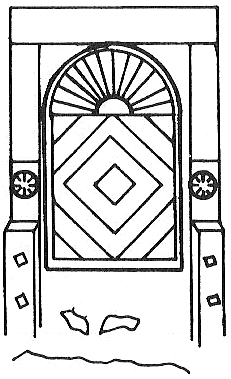
Fig. 18. Sun-door of Csik Szent-Király, with a geometric decoration.
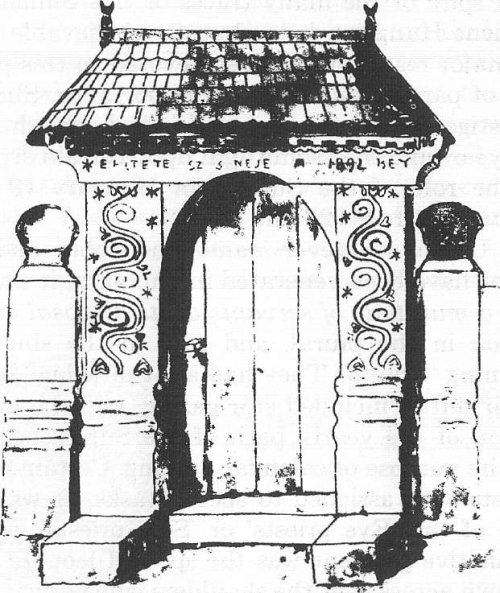
Fig. 19. Elaborate Sungate of Harasztosi, Hungary, flanked by two idols.
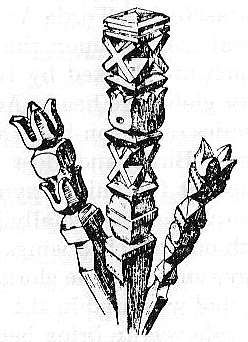
Fig. 20. Wooden columns on burial sites in present-day Hungary.
Anthropomorphic representations of God were less frequent. Hungarian archaeologists have nevertheless unearthed a beautiful terracotta divine statuette, representing a man, sitting on a throne and holding the Isten-symbol in his hand (Fig. 23). On the other hand, the human eye was often used to represent God on numerous occasions, probably because the Sun was considered as an all-seeing One-Eyed Giant. In this connection he was called Szem- Ur and Szemes 'Eye God' and 'He who has an Eye'. The eye-motive is one of the most frequent decorative elements in Hungarian folklore and is called Isten szeme 'God's Eye' (P 014 p. 78). Several villages and rivers were placed under the protection of the Eye-God, e.g. Szemes-on-Lake Balaton, Szomoroc and the river Szamos (= Szemes).
In spite of the many traces of this Suncult in Ancient Hungary, it is almost unbelievable that no major research has been devoted to this problem of paramount historical importance. Shorter investigations have only been made during the last few years and shed some light upon certain aspects of the role of the Sungod in Hungary (P 004; P 003; P 121; P 020 and P 122).
3. Under whatever name the solar divinity might have been venerated in Hungary, it always had a multitude of servants at its disposal called Papok in the plural, and Pap in the singular, meaning 'Priests'. They had a lot of things to do. Their duties included star-gazing, and the observation of the yearly path of the Sun, especially for the purpose of calendar-making. Certain other priests were assigned to special tasks, as was the case of the 'Eye priests' or 'Sem priests', whose distinctive garment was the spotted leopard skin thrown across over the shoulders when officiating. A further group of special priests consisted of 'Male priests' (Kan papok), whose exact duties have, however, not yet been elucidated with sufficient clarity. At any rate, this saying was associated with them: Kár a kanpapnak a rák, which reads identically from both ends and means that "it is futile serving crab to a male priest." This is because he dares not eat it, crabs being sacred to the solar divinity. Every priest used holy water extensively when officiating, exercised many charms and often wore a mask. When he was not wearing one, a feather was his usual head ornament.
Amongst the intermediaries between God and his followers, the Táltos or Tátos, 'Scientists' had a somewhat spectacular role, similar to that of the medicine-men. Their name originates from the word Tudó (< O.H.: Tutu), meaning literally 'He who has knowledge.' They also were known as Bölcsek 'Wise men'. They were capable of curing diseases, averting elemental catastrophes, knew how to purify wells, and could reveal the whereabouts of stolen objects, and so on. Their ceremonial garment was made of feathers, and a long one was fixed upon the head. Their footwear was also decorated with bird-claws. They spoke the bird-language (bird = madár = Magyar), and their equipment included a ladder (P 040; P 047; P 086). The Tátos had the power of ascending to Heaven and entering into direct contact with the Sungod. To this end he used his high ladder. The presence of a ladder, Létra in Hungarian, was to emphasize, pictorially, the sense of the ceremony, this word being homophonous with the abstract idea of Lát-Ra: "Ra (the Sungod) sees me."(24)
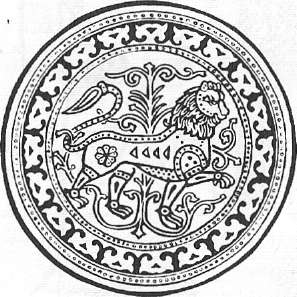
Fig. 21. 'The Lion of Esztergom'. Wall-painting in the royal palace, Hungary, Xllth century.
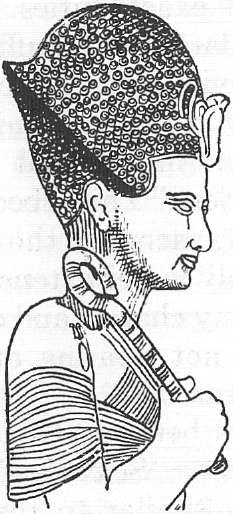
Fig. 22. Ramses II, King of Egypt (1304-1232 B.C.), holding the God-symbol.
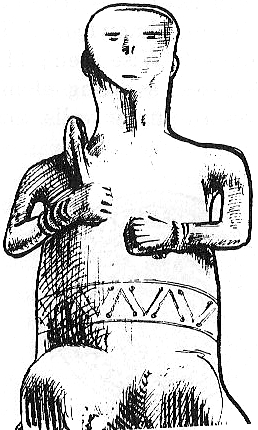
Fig. 23. Human-shaped divinity with the God-symbol. Hungary, Neolithic Age.
The most important religious feast was the winter solstice on December 25th when the Sun, after having reached the lowest point of its yearly wanderings, began to rise again. The 'Returning Sun' or 'Reborn Sun' was celebrated in all corners of the country with the performance of a drama whose central theme was a miraculous deer coming through the clouds from Heaven, bearing and bringing back between its horns, the shining disk of the Sun (P 015 p. 71). The summer solstice on June 21 was another great religious holiday in Ancient Hungary. Its purpose was to celebrate the glorious rising of the Sun to the peak of its yearly path. It was marked with colossal mountain-top fireworks.
In Old Hungarian religious thinking, death was not considered the end of man's existence-, it was rather regarded as the most important turning point of a life which continued thereafter in eternal happiness in the company of the Big Bird, as an 'Associated bird', i.e. a semi-divine being. The transition from earthly to eternal life was marked with great solemnities. The coffin of the well-to-do farmer was carried to the grave on a cart drawn by six oxen and various objects were put into the coffin, a custom proving belief in an afterlife. Amongst such objects, a needle and thread were also included to enable the deceased to mend his garment when necessary. Money was also put into the hand of the deceased so that he could pay for the toll when marching over the plank leading to the other world. And the grave-digger had to be reminded to make a 'window' on the new home of the defunct, so that he might come up on certain days to see his divine master the Sun (P 077 p. 59-62).
The memory of the defunct was kept alive by a stone monument erected upon the grave and provided with a short inscription and geometric symbols. A special Hungarian feature was the equilateral cross sign MAS carved within a circle (AR or RA), stating that the defunct had become Mas-Ar or Ra-Mas 'Deputy for God' or a 'Hero'. Another widely spread custom was — and is even today — to mark the burial place with a beautifully-carved wooden column made by the deceased himself before his death. This column reveals to the initiated the sex, age, rank and wealth of the dead person. In the case of a male, the top of the column is usually conic while that of a female is hollow or tulip-shaped. The column commemorating a child is usually smaller in size and light in colour (Fig. 20; P 135 and P 069).
4. How long may the suncult have been practised by the Hungarians? In connection with this question we have to remember that Estonians and Finns originally lived together with a group of Hungarian-speaking peoples until their ways parted around 2000 B.C. and, notwithstanding the great time-span separating them, they too have kept alive a substantial number of identical Sun-symbols in their folklore. The giant tree reaching into Heaven is called in Finnish Sam-Po, pronounced Szem-Fa in Hungarian (after P > F), 'Eye-God's Tree'; while Sam-Mas in Finnish resembles the Hungarian Szem-Mas 'Deputy for Eye-God'. Such and similar concordances suggest that the Suncult belonged to the spiritual heritage of all Hungarians of any denomination before 2000 B.C. Another time-element is to be found in the Old Hungarian ballad "Julia, the beautiful girl." Reference is made therein to the spring equinox which was then celebrated during the zodiacal constellation of the Bull (Taurus) group of stars. It is now known from astronomical calculations that said constellation occurred just around 2000 B.C. (P 122). As mentioned above, this chronological evidence confirms that the Suncult was practised by early Hungarians in the New Stone Age, or perhaps even earlier.
The age of the Suncult in the Danubian basin itself can be guessed upon the basis of archaeological finds adorned with solar symbols. Numerous such relics have been unearthed since 4000 B.C. Danubian farmers, in particular, carried the spiral, the meander and the other geometrical designs everywhere across Europe (P 064 p. 332). Hungarian archaeologists have brought to light miniature cart-models — Sungod chariots — at seventeen different places, all fitted with discwheels and dated c. 2700 B.C. and 2300 B.C. Sun symbols continued to appear in Hungary, without interruption, during the Copper Age (3500 B.C. - 1900 B.C.) and during the Bronze Age (1900 B.C. - 900 B.C.). And later, when the Roman Empire ruled in large parts of Hungary, in the first three centuries of the Christian era, a magnificent Sun-temple was erected in the City of Savaria, the present Szombathely. It was the greatest such temple ever built in Europe (16.5 m X 9.5 m), displaying a giant Sun-disc above its altar.
All the quoted data prove that Sun-worship was a regular feature in the spiritual life of Hungary from the beginning of Neolithic times until the adoption of Christianity. It survived even after that turning-point, as witnessed by the great amount of evidence found in folklore, place-names, mythology and history.
Concerning the geographical origin of the Danubian Sun-cult, all our evidence points toward Ancient Egypt and Mesopotamia. Hungarian scientists working on this specific field, prefer, nevertheless, to emphasize the primary importance of Mesopotamia (Sumer). To support their view, they cite the numerous concordances existing between the two countries' mythology, they mention the absolute similarity of the Sumerian and Hungarian names for Sun (Nap), Lord (Ur) and God (Isten) and insist upon the parallels existing between the two countries' inhumation practices. All these concordances, as well as many others are undisputable. Non the less, the concordances between Hungary and Ancient Egypt are by far more numerous and far more important. Not only were the general names of the Sungod identical: Ur, Isten, Nap, Madár, but also the specific names: Sky-God (Ég Ura), Eye God (Szem-Ur), Travelling Lord (Ut-Ur), as well. A similarly striking resemblance exists between the priestly class of the two countries, beginning with the generic name Pap 'Priest'. Egypt had also its Eye-priests (Sem-priests) whose ceremonial garment, also of spotted panther skin, was thrown across the shoulders. Egyptian priest, gods and high-ranking officials also often appeared in ornitomorphic garments, as did their Hungarian counterparts who had, at least, one bird-feather fixed upon their heads. The feast of the reborn Sun (December 25) was celebrated all over Egypt with the same ardour as in Hungary, and so was the important date (June 21) of the summer solstice. The Sungod's paramount symbol was, on both occasions, the shining disc. The burying of the deceased was just as ceremonial in Egypt as in Hungary. The Egyptians also believed that the soul of the deceased departed from the body at the moment of death and flew on wings to his heavenly creator to become his companion for ever. In Egypt the physical remains of the dead person were also put in a grave, accompanied by such objects the deceased may have need for in his new life, which is also similar to Hungarian practice. And in the 'house' of the deceased in Egypt, an opening or shaft had to be made so that sunbeams could penetrate through it at certain hours of the day. Even a ladder was put into the grave, or at least the picture of a high ladder, to enable the deceased to climb on it and see the Sun. Without adding any more to the list of Egypto-Hungarian concordances, we may conclude by saying that Hungary has preserved almost the entire mythological heritage of Ancient Egypt of the IIIrd and IInd millenia B.C., even two thousand years after Egypt's beacon had been extinguished.
5. Traces of a second religion can also be detected in Hungary's folklore. This was the so-called fertility cult which was totally different from the Suncult. Its purpose was earthly: to insure fertility both in the human and animal worlds. Its central divinity was the Mother Goddess whose two main Hungarian names were Great Lady (Nagy Asszony) and Happy Lady (Boldog Asszony.) Her memory is preserved in anthropomorphic symbols, the so-called Venuses, which are small statuettes representing a naked woman.
Ample anthropological evidence suggests that the fertility cult is as old in Hungary as the Suncult itself. Scholars have, indeed, dug up a considerable number of Venuses dating from the Neolithic Age (3000 B.C. — or even earlier). These figurines are of two kinds: elaborate, ornate anthropomorphic Venuses, and small statuettes of baked clay. A particularly ornate Venus statuette was found on the Neolithic site of Kökény-Domb, near Hód-Mező-Vásárhely which possesses all the characteristics of a Mother Goddess, including her strongly accentuated femininity. Small Venuses were found on almost every excavated Neolithic site. In Méhtelek, however, near the Upper Tisza river, a single place has yielded over sixty such figurines. Amongst these statuettes several were of steatopygous type, indicating the presence of African elements in the population.
Comparative archaelogy has established beyond a doubt that the Hungarian fertility cult originated in the Eastern Mediterranean, especially Canaan, Syria, Phoenicia and Anatolia, which were the homelands of the Baals, As-Tart, As-Turat,
Kedves, Telepinus and others with clear Hungarian names which seem rather coarse to-day. The fertility cult seems to have been the apanage of the darkish coloured ethnic element whose principal lifestyle was stock-breeding, while the Suncult may be attributed to the agricultural, white population.
3. The Oriental background of the first Hungarian dynasty
1. The origin of the first Hungarian dynasty is shrouded in deep mystery. One thing is however certain, namely that Prince Almus, father of Arpad, was its first great figure. His throne-name, Almus, is a compound-word of two elements: Eld + Masa and signifies 'Deputy for the Living (God)', an Oriental title, perfectly suited to describe the office Almus held, that of the native ruler of the autonomous group of Hungarians, subjects of the Chasar Great-King, the 'living god'. That Almus was a ruler's title is confirmed by the additional fact that the native ruler of the Bulgars, who lived on the shores of the river Volga in c. 921, had an identical throne-name.
Further evidence that Almus was the first important figure of the Hungarian dynasty is his divine origin. In the Ancien Orient, it was indeed a widespread belief that great kings, especially founders of dynasties, were superhuman beings and were therefore fathered, not by ordinary earthly beings, as the common mortals, but by the Heavenly God. This god was supposed to return to Earth in the shape of a bird, on the very night of the conception of a future sovereign, to impregnate the expectant mother personally. In ancient Mesopotamia the divine impregnator took the form of an eagle, called Turullo; in ancient Syria the fertility god was As-Tur, and in ancient Egypt the Pharaohs were conceived directly by Ra, the Sungod.(25) The mother of Almus was also visited that specific night by a divine bird called Astur (< Az Túr) or Turul (< Túró Ló) 'Fecundator, Impregnator', who foretold that from her womb glorious kings would be born.(26) Because of their divine origin through the solar bird Turul, the descendants of Almus were known as the Turul progeny.
In addition to the "Turul legend", the Oriental background of the first Magyar dynasty again becomes visible in the physical features of the first divine infant, Almus. "He was pleasant-faced, but darkish coloured; had big eyes, a tall and slender stature, with big hands and puffy fingers."(27) The description of Almus' general appearance baffled scholars ever since, because the Prince resembled an Egyptian Pharaoh of the late dynastic times much more than the presumed Uralo-Siberian white man. The features of Almus are no longer a problem: on the contrary, they provide further strong evidence of the dynasty's Near-Eastern origin.(28)
In the year 895, when the military conquest of Hungary was in progress, Prince Almus led the southern wing of the army-group, scheduled to penetrate into the Carpathian basin from the southeast, by way of the Lower Danube. His son, Prince Arpad, headed the northern army-group, which was equipped in Kiev, and was supposed to enter into the selected land through the northeastern pass of Verecke (841 m). Father and son both were to meet inside the Carpathian arc, on the lowland, the military target of their giant pincer-movement. Almus was however unable to complete his task in time due to the unexpected assault of the Petchenegs from behind. For his misfortune, it seems, he was ritually killed by his followers on the outer foothills of the Carpathians. This barbaric custom of eliminating an unsuccessful leader was another Oriental practice, similar to that of Biblical Moses who would not see the promised land, but had to die before he reached his goal to atone for some sin he had committed.
2. Arpad, is the most illustrious name in Hungary's history. According to records preserved in medieval chronicles, this Prince was a descendant of King Attila, the world-conqueror (+453). His illustrious kinship with him might have been, however, only a distant one, considering that more than four hundred years separated Arpad from his presumed forebear. Anonymus, the unnamed medieval historian (c. 1200), when discussing this subject seems to share this view, stating simply that Prince Almus, father of Arpad, descended from an offspring of King Attila. Be it as it may, the real or fictive kinship with Attila helped Prince Arpad tremendously to consolidate his grip upon the entire central Danubian basin, the future Hungary. He proclaimed indeed, everywhere and repeatedly, that he was not coming as a vulgar conqueror to create bloodshed, but as the legitimate successor to his forebear King Attila, to take possession of his heritage. And the inhabitants of the land, hearing this and seeing Arpad's mighty armies, bowed before their new master.
The name Arpad was also a throne-name with a definite meaning. Chronicler Anonymus, the often cited notary of King Béla, spells the name on one occasion thus: ARpad (P 120 I p. 57), with the intent perhaps to warn us that the name is a compound, made up of Ar + Pad. If so, he was right, because Ar-Pad follows the pattern of Mat + Ar and Hung + Ar, with the difference that in Arpad the composing elements appear in an inverted sequence: Ar-Pat instead of Pad-Ar. Now, the meaning of Ar is known: 'Lord, Ruler, Sovereign'; and so is that of Pad or Pod (to-day: Fold) 'Earth, Land' (after P > F soundshift and the elision of the jammed L in Fold). Accordingly, Arpad means 'Sovereign Ruler of the Land'. Once again, the indication of the Prince's status is exact: it reflects the Chasar king's policy to gradually promote the Hungarian native ruler to a more independent status.
Further light can be shed upon Arpad's Oriental connections by examining his Near Eastern homonyms. There was, indeed, a "Kingdom of Arpad" in ancient Syria in the first millenium B.C. It was a city-state located near the great bend of the Euphrates river, some 20 km north-west of Aleppo. Its former site is known today as Erfet (after P > F soundshift), to which an important ford on the Euphrates belonged. The Kingdom is mentioned several times in the Bible (II Kings c. 18/34 and c. 19/13). Its mortal enemy was the Semitic Kingdom of Assyria, against whom King Mati'ilus (= Magyar) organized the common defense with the Urartian king Sarduris III. The formidable Assyrian army had to lay a three-year siege around the city before reducing it into submission in 740 B.C. A few years later, the ruler of the kingdom tried to regain his independence, but he failed and his domain was completely obliterated. The population fled on the only escape route that was still open: northwards, through the Euphrates valley, to settle beyond the Caucasus mountains. All these tragic events must have been linked somehow with the emergence of a Caucasian Hungarian Kingdom, proof of which is that in both areas — in Syria and in the Caucasus — Magyar place-names are o found in super-abundant numbers.
Regarding the throne-name Arpad, it goes back into history even farther. The ancient Egyptians revered, e.g. a ruler of that name as their very first king.(29) The name Arpad or Erpet is mentioned several times in the Egyptian "Book of the Dead" (P 027 pp. 18, 138, 435 and 649). It was again an Arpad who, after having reunited the desintegrat-ed country, assumed the royal dignity in Thebes and founded the XIth Dynasty (P 025 II p. 196 and f., see hieroglyphs ibidem). Due to the great role Arpad played in ancient Egypt, Prof. Gardiner and W. Budge made extensive researches to find out more about this legendary name. They concluded that it was written with four sound-signs as AR-P-A-T or AR-P-A-D, followed by two determinatives. The first one was that of 'Cloth, Earth, Land', and the second, a human figure, indicating that the person so named was a great-man. Thus the Egyptian name Ar-Pad meant literally 'Land Lord', i.e. owner of an important agricultural domain somewhere along the fertile shore of the river Nile.(30) When the determinatives were omitted, as was usually the case in well-known names, the expression became a simple name. These data prove that 'Arpad' was a very ancient royal title and that its bearers had sojourned at length in Syria and especially in Egypt, before entering into Danubian Hungary.(31)
3. How were the titles of the Hungarian kings written pictorially? It was done with the figure of a lion, because the name of this animal, Oroszlán, sounded like the expression Ur-Ös-Lény 'Primeval Being of Divine Origin'. The earliest extant lion symbol used by the Arpad dynasty in Hungary was the one carved upon the crystal globe of the coronation sceptre, originating from the Xth century. According to archaeologists, the crystal in question is of Egyptian origin, this being the only country where it is found (P 003 p. 59, 62). A more elaborate lion-symbol was found painted on an interior wall of the royal palace in Esztergom, built in the XIIth century. It could be reconstructed into its original form with what remained of its former parts (Fig. 21). Other lions kept close guard before an interior well of the royal palace of Visegrád (XVth century). Furthermore, the seven sovereign Magyar princes who elected Arpad to be their ruler and commander, also had lions on their coats of arms. The custom of representing royalties by lions also goes back to Mesopotamia, Egypt and India, as mentioned before. In Mesopotamia, the lion had already been the royal symbol of Gilgamesh, the legendary ruler of Uruk, who was usually shown with a lion cub. In Egypt, the lion was the regular companion of the kings and farther east, in India, it was particularly in evidence during the Maury (= Magyar) dynasty. These kings erected huge columns with lions placed on top throughout their vast domain. Thus, there can be no doubt as to the origin and meaning of the lion symbol which clearly indicates the Oriental background of the Arpad dynasty.
The Arpadian coat of arms had seven horizontal stripes, four red and three white. It perpetuated the memory of the Seven Magyar Princes who concluded a contract of mutual blood-relationship to henceforth form a single nation. The stripes, in horizontal arrangement, signify, in the old
Egyptian hieroglyphic system, as many 'Land Lords', Hon-úr (Aner). Thus the seven stripes mean Hét Honúr 'Seven Land Lords'. The number seven was considered the lucky number all over the Ancient Near East.(32) In addition to the striped escutcheon, Hungarian kings used a second shield as well, consisting of a double cross rising from a three-arched base. When these elements are read according to the rules of the carved script, the following word emerges: the double cross carries the syllable eGY, one arch is the sign for the Sh sound, three arches signal the plural case: Sh.ek, and these sounds, put together, form the word egy-esh.ek, i.e. Egyezség, meaning 'Agreement, Pact, Alliance', which is another reference to the contract of blood-relationship.(33) The stripes and the double cross were later placed upon a single shield, which was divided into two halves by a vertical line. Thus, the shield conveys the following meaning to us: Hét Honúr egyezsége 'Agree-ment of Seven Princes'. This combined figure became Hungary's heraldical symbol until it was officially discarded by the communist régime.
At first, Hungary, had two royal crowns, a Corona Graeca and a Corona Latina, so named after their respective origin. A few centuries later, the two crowns were welded together, to form a single one. There is no plausible explanation for this act, says Prof. Áldásy, a leading authority in Hungarian heraldry. The mystery may, however, be solved since a similar event had taken place in ancient Egypt. Originally, there were two crowns in this country, one for Upper and another for Lower Egypt. And when the two lands were reunited into a single domain, and the fusion of the two states had reached an advanced stage, the two crowns were reunited into one. It is possible that the fusion of the Hungarian crowns may have been prompted by this or by some other similar event.
Through the various facets of the first Hungarian dynasty (1000-1301) which we analyzed, we were led to the conclusion that this dynasty was deeply imbued with Oriental thinking. And what regards the founder of this dynasty, Prince Arpad, there cannot be the slightest doubt that he descended from a, long line of ruling families, experienced in leadership.
4. How the Nation remembered its origin
Most of the existing traditions relating to the origin of the Hungarians have been recorded during the XHIth and XIVth centuries. These written accounts, called Gesta (deeds of valour) or Chronicles (annals) are continuous narratives, usually in the Latin language, reflecting a religious and patriotic spirit.(34) The earliest and most valuable Gesta Hungarorum was written by the unnamed (Anonymus) notary of King Béla, between 1196 and 1203. The author, a former student at Paris University, served in the royal Hungarian Chancellery, and was later elevated to the rank of bishop. The topic of his work is the successful re-conquest of the Middle Danube basin by Prince Arpad, leader of the Magyar tribal confederation at the end of the IXth century. The next important national chronicle was written in c. 1282 by Magister Simon de Kéza ('Kézai' in Hungarian), court chaplain of King Ladislas IV (1272-1299) a ruler with avowed heathen leanings. The freer atmosphere prevailing in the king's court permitted Kézai to devote a large part of his book to the old fatherland and to assert the identity of the Magyars and Huns, regarding Attila as a Magyar king. Therefore, in his view, the advent of Prince Arpad and his followers in 895 appears as the "second entry" of Hungarians into the chosen land. After Anonymus and Kézai, several other national chronicles were written, one of the most eminent having been the admirably illustrated Chronicon Pictum (c. 1385). There is also a Tarihi Ungurus (History of Hungarians), translated into Turkish from an unknown Latin original, after 1543.
What the chronicles knew about the Hungarians' ancient history is briefly summarized on the following pages, namely: (1) the genesis of the people, (2) the geographic location of the old fatherland, and (3) their migration toward the West. Both Anonymus and Kézai were convinced that the Magyars are an ancient people, originating right after the Flood, when all human beings were drowned, except a single family: that of Noah. They assert that the early Magyars were the direct descendants of two sons of Noah: Japhet and Cham. Those who recorded the descent from Japhet claimed that Magog, the first king of Scythia, was the namegiver of the Magyars.(35) The scholars holding the second version say that the Magyars originated from Kush (Cush), the dark complexioned offspring of Cham. While studying the contradictory versions of the Magyars' ethnic origin, later chroniclers stressed their own case more emphatically. The advocates of the Japhetist descent underscore the fact that the Hungarians, being white, could not have originated from Kush, who was a dark coloured man.(36)
A similar controversy arose about the brothers Hunor and Magyar, the direct forefathers of all Huns and all Magyars. At one time they were said to have been the children of Menrot, the giant (an Egyptian?),(37) who was a descendant of Japhet (the white) through Tana; and at another, as the sons of Nemroth (Nimrod), a Babylonian, descendant of Kush (the dark). The chroniclers did not consider the possibility of a dual origin of the Nation, according to which the main branch, the agriculturist white Magyars, would have absorbed a notable number of dark-complexioned, mainly pastoral elements in the earliest phase of their formation. The fusion of the said two ethnic elements was first ascertained only later by De-seritzky (P 092 p. 179). Disregarding the above differences, there exists a general agreement amongst our medieval historians that the Hungarians were a very ancient people and the Scythians and Huns were closely related to them and spoke the same language.
Where was the Old Fatherland located? Somewhere in the "Hot Zone" (torrida zona), "where the climate is not temperate and where snakes of all kinds, frogs as large as small pigs ( = tortoises), basilisks, many venomous animals, also tigers and rhinoceroses are to be found." That was a land where great quantities of gold and silver were mined and many pearls discovered. It is unfortunate that the chroniclers did not elaborate and that they omitted to give the name and the precise location of this country. In the absence of precision, we can only rely upon conjectures, concluding that the description given fits best to the region west of the Red Sea, the S-form bend of the Nile where ancient Nubia and Magaria were situated. There were the famous gold fields, wherefrom the Egyptian Pharaohs obtained their enormous gold supply and where all the tropical animals mentioned are common. Giant tortoises are the typical creatures abounding in the Red Sea.(38)
There are indications in the national chronicles which suggest that a second old Hungarian fatherland may have existed, south of the Caucasus, extending to the Mediterranean and including Syria, Canaan and Asia Minor as well. It was in this same area that the Hittite Empire had come into being, called the 'Land of Seven', because it started with the unification of seven provinces governed by as many princes. The chronicles mention that the same region has been an old Hungarian fatherland. In fact, the chronicles say that "the sons of Japhet / from whom the bulk of Hungarians originated / owned the northern region in Cilicia and Syria, extending from the Taurus and Amanus mountains to the river Don, which is already in Scythia" (P 12G I p. 243 f.). We even have certain evidence of the existence of a third Hungarian homeland which was situated in the hinterland of the Babylonian Empire and included Upper Mesopotamia and Caucasia. Our chroniclers believe that Nimrod (Nemproth) was the first ruler of Babylon.
The making and the breaking-up of old Hungarian fatherlands was usually accompanied by vast ethnic movements or 'migrations'. Their direction was mostly northward and westward. In the national recollection, the earliest recorded migration started in the desert region of Dancalia (today: Danakil), between Somalia and Eritrea, and proceeded northwards, bypassed Memphis and Babylon (today: Old Cairo) and stopped for a while in Eiulath, at the end of the Gulf of Aqaba (P 088 p. 17; P 120 I pp. 143-145; P 014 p. 167). The two hunting heroes, Hunor and Magyar, who happened to be born in Eiulath, later crossed the Caucasus and entered Scythia at the Marshes of Maeotis (the present day Azov peninsula).
The Magyar chronicles are, of course, primarily interested in the ethnic groups which moved westwards and eventually reached Hungary. One such migration started from Troy in Asia Minor and went through the Balkan peninsula. It was the people of Priamos, the last king of Troy, who went that way after the fall of their city-state in c. 1260 B.C. They settled in Hungary, near the great southward bend of the Danube, where they built a stronghold called Sicambria. They remained in the country for about four hundred years, when many of them moved over to France, settling in the Paris region. They had fled in panic fearing that other Oriental nations were already on their way to the Danube basin (P 120 I p. 245).
The chronicle writers had preserved more details on a second overland route, leading from the Orient to Hungary. It ran above the Black Sea, through a large and open country called Scythia (the present southern Russia). Although Scythia's climate was a healthy one and favourable for the propagation of a human race, it was nevertheless considered as a transit country only. This land was, indeed, overcrowded with various peoples and had become more and more insecure. As is known, the Hun-Hungarians were the first great group to set out from there, marched westwards and were successful in establishing a new empire in Central Europe, with its capital in Hungary, near the confluence of the rivers Tisza and Maros. After the collapse of their rule, they were followed by the Magyar-Hungarians, whose group first concentrated in the Lower Don region, called Dentu-Moger by Anonymus. Chronicler Kézai enlarges the territory of the Hungarians in Scythia considerably, insofar as he includes the Touranian Lowland around the Aral Sea and the Oxus river into it, which he calls Magoria.
In short, these are the outlines of the image the Hungarians kept alive in their collective memory of their origin, old fatherland, and wanderings. We must feel a certain admiration when studying their records, all the more so since modern historical science appears generally to support their claims.
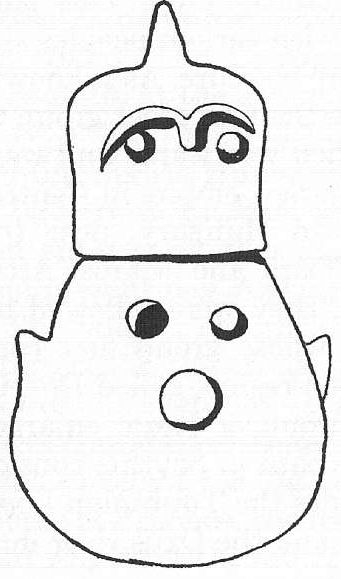
Fig. 24. A typical Troy-II vessel, c. 2300 B.C.
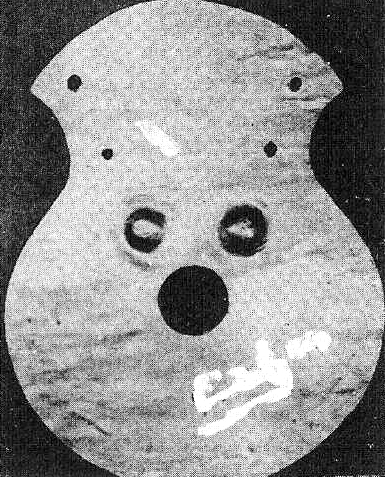
Fig. 25. Gold badge of a high priest. Mojgrád, Hungary, Bronze Age.

